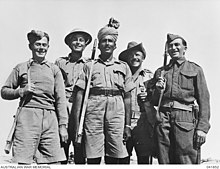
Back حصار طبرق Arabic Обсада на Тобрук Bulgarian Setge de Tobruk Catalan Obléhání Tobruku Czech Belagerung von Tobruk German Πολιορκία του Τομπρούκ Greek Sieĝo de Tobruko Esperanto Sitio de Tobruk Spanish محاصره طبرق Persian Tobrukin piiritys Finnish
| Siege of Tobruk | |||||||
|---|---|---|---|---|---|---|---|
| Part of the Western Desert campaign of the Mediterranean and Middle East theatre of World War II | |||||||
 Soldiers of the victorious Allied armies: Polish, British, Indian, Australian, and Czechoslovak | |||||||
| |||||||
| Belligerents | |||||||
|
|
| ||||||
| Commanders and leaders | |||||||
|
|
| ||||||
| Strength | |||||||
| 27,000[citation needed] | 35,000[citation needed] | ||||||
| Casualties and losses | |||||||
| 5,989 |
12,296 74–150 aircraft | ||||||
The siege of Tobruk (/təˈbrʊk, toʊ-/) took place between 10 April and 27 November 1941, during the Western Desert campaign (1940–1943) of the Second World War. An Allied force, consisting mostly of the 9th Australian Division, commanded by Lieutenant-General Leslie Morshead, was besieged in the North African port of Tobruk by German and Italian forces. The tenacious defenders quickly became known as the Rats of Tobruk. After 231 days, they were finally relieved by the British Eighth Army.
In late 1940, the Allies had defeated the Italian 10th Army during Operation Compass (9 December 1940 – 9 February 1941) and trapped the remnants at Beda Fomm. On 22 January 1941, Tobruk's Italian garrison surrendered. But in early 1941, much of the British Western Desert Force was sent to the Greek and Syria–Lebanon campaigns, leaving only a skeleton force short of equipment and supplies.
Adolf Hitler felt compelled to send reinforcements, commanded by Generalleutnant Erwin Rommel, to rescue his beleaguered Italian ally. Rommel launched Operation Sonnenblume (6 February – 25 May 1941), driving the Allies back across Libya to the Egyptian border. However, Tobruk held out, depriving Rommel of a supply port closer to the Egyptian–Libyan border than Benghazi, 560 mi (900 km) west of the Egyptian frontier. The Axis siege of Tobruk began on 10 April and continued despite two failed Allied relief attempts: Operation Brevity (15–16 May) and Operation Battleaxe (15–17 June). The garrison repulsed several Axis attacks. The port was frequently bombarded by artillery, dive-bombers and medium bombers, while the Royal Air Force flew defensive sorties from airfields far away in Egypt. Allied naval forces, such as the British Mediterranean Fleet (including the Inshore Squadron) ran the blockade, carrying reinforcements and supplies in and the wounded and prisoners out. Finally, Operation Crusader (18 November – 30 December) succeeded in raising the siege.

